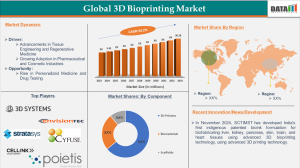3D Bioprinting Market Size, Trends & Forecast 2025-2033 | Data-Driven Insights By DataM Intelligence
The 3D Bioprinting Market Hit $3.45B in 2024 and is forecasted to reach $30.28B by 2033, growing at a strong CAGR of 24.2% from 2025 to 2033.
The 3D bioprinting market is experiencing a remarkable surge as it reshapes the future of healthcare, pharmaceuticals, and regenerative medicine. This innovative technology, which uses layer-by-layer printing to create biological tissues and organs, is steadily transforming traditional medical procedures and research methodologies. With expanding applications ranging from drug development to personalized medicine, the market is set to witness significant growth in the coming years.
Market Value and Growth Outlook
As of 2025, the 3D Bioprinting Market Size was estimated to be worth approximately USD 3.45 Billion in 2024. It is anticipated to witness substantial growth, reaching nearly USD 30.28 Billion By 2033, driven by a robust compound annual growth rate (CAGR) of 24.2% over the forecast period from 2025 to 2033.
To Download Sample Report: https://www.datamintelligence.com/download-sample/3d-bioprinting-market
This growth is propelled by increasing investments in research and development, rising demand for organ transplants, and growing awareness about the potential of tissue engineering. The ability to customize bioprinted tissues tailored to individual patient needs is a key driver that distinguishes this market from conventional medical manufacturing.
Advances in bio-inks, bioprinters, and 3D printing techniques continue to enhance the precision and viability of printed tissues. As the cost of bioprinting gradually decreases and technology becomes more accessible, more research institutions and medical practitioners are integrating it into their workflows. This rising adoption, combined with ongoing regulatory support in various regions, is catalyzing the overall market expansion.
Regional Outlook
The global 3D bioprinting market shows varied dynamics across regions, with North America, Europe, and Asia-Pacific emerging as the most influential players.
North America remains a dominant market due to its well-established healthcare infrastructure, strong presence of key market players, and substantial government funding directed toward innovative healthcare technologies. The U.S., in particular, leads in research collaborations and clinical trials involving bioprinting applications.
Europe is also a significant contributor, driven by increasing collaborations between academic research institutions and bioprinting firms. Nations such as Germany, the United Kingdom, and France are enhancing their regulatory policies to facilitate the market adoption and commercialization of bioprinting technologies.
Asia-Pacific is one of the fastest-growing markets for 3D bioprinting, buoyed by rapid advancements in medical technology and increasing healthcare expenditures in countries such as Japan, China, and South Korea. Investments in R&D and growing biotech startups are pushing the region toward becoming a hub for bioprinting innovation.
Emerging economies in Latin America and the Middle East are also gradually embracing 3D bioprinting, particularly for drug testing and personalized medicine, which indicates a broadening horizon for the market.
Key Companies and Competitive Landscape
The 3D bioprinting market is highly competitive and marked by continuous innovation. Leading companies are investing heavily in new technologies and strategic partnerships to maintain their market positions. Some of the major players driving this space include:
3D Systems Corporation
EnvisionTEC GmbH
Stratasys Ltd
Cyfuse Biomedical KK
Cellink
Poietis
RegenHU SA
Market Segmentation:
By Component: 3D Printers, Biomaterials, Scaffolds
By Technology: Inkjet-Based Bioprinting, Syringe-Based Bioprinting, Laser-Based Bioprinting, Others
By Application: Venipuncture Assistance, Medical Pills, Prosthetics and Implants, Dental, Biosensors, Consumer/Personal Product Testing, Bioinks, Food and Animal Products
By End User: Research Organizations and Academic Institutes, Biopharmaceutical Companies, Hospitals, Others
Latest News of USA
In 2025, the United States continues to lead in 3D bioprinting innovation, highlighted by several recent developments:
A breakthrough collaboration between a leading biotech firm and a top research university has successfully bioprinted a functional human liver tissue. This tissue can be used for drug toxicity testing, potentially reducing the need for animal testing and accelerating drug development timelines.
Federal funding for bioprinting projects has increased substantially, with the National Institutes of Health (NIH) launching new grants aimed at regenerative medicine. These funds support both the refinement of bio-inks and the development of bioprinters capable of producing more complex tissues.
The FDA has made progress in establishing regulatory pathways specific to bioprinted medical products, allowing faster approvals while ensuring patient safety. This improved regulatory transparency is motivating a growing number of startups to venture into the bioprinting sector.
Several U.S. companies are also exploring bioprinting for personalized cancer treatments, where tumor tissues are printed to test drug responses, allowing oncologists to tailor therapies more precisely.
Latest News of Japan
Japan is making significant strides in the 3D bioprinting market as well, with key developments shaping the industry:
A Japanese research institute recently announced the successful bioprinting of cardiac muscle tissue with enhanced contractile function, bringing hope to patients with heart diseases. This advance marks a step closer to the possibility of printing full heart tissues for transplantation.
The Japanese government has launched initiatives to support regenerative medicine and bioprinting technologies as part of its national strategy for advanced healthcare innovation. These initiatives include subsidies for startups and collaborations between academia and industry.
Several Japanese companies are focusing on bio-ink development using indigenous biomaterials, aiming to improve compatibility and reduce immune rejection risks in transplanted tissues.
Japan is also fostering international partnerships, sharing its expertise in robotics and precision engineering with global bioprinting firms to develop next-generation bioprinters that offer greater accuracy and speed.
Conclusion
The 3D bioprinting market is on an exciting growth trajectory, fueled by technological breakthroughs, increased funding, and global collaborations. With North America and Asia-Pacific leading the charge and Japan’s innovative approaches adding unique value, the industry is poised to revolutionize healthcare and pharmaceuticals. As challenges like scalability and regulatory complexities continue to be addressed, 3D bioprinting promises to unlock new possibilities in personalized medicine, organ transplantation, and drug discovery, ultimately improving patient outcomes worldwide.
Stay informed with the latest industry insights - start your subscription now: https://www.datamintelligence.com/reports-subscription
Here are the Most Trending Related Reports By DataM Intelligence
Vocal Fold Augmentation Market Size By 2031
Medical Aesthetics Market Size By 2031
Sai Kiran
DataM Intelligence 4Market Research
+1 877-441-4866
Sai.k@datamintelligence.com
Visit us on social media:
LinkedIn
X
Legal Disclaimer:
EIN Presswire provides this news content "as is" without warranty of any kind. We do not accept any responsibility or liability for the accuracy, content, images, videos, licenses, completeness, legality, or reliability of the information contained in this article. If you have any complaints or copyright issues related to this article, kindly contact the author above.
Michigan Buyers Can Find Their Dream Homes Faster with Houzeo’s Smart Search Filters
Castor Oil Derivatives Market Growth and Forecasting for next Upcoming Year Until 2031
M-Xylylenediamine Market to Reach USD 550 Mn by 2034, Driven by Growing Demand in Construction and Automotive Industries
Więcej ważnych informacji
 Jedynka Newserii
Jedynka Newserii

 Jedynka Newserii
Jedynka Newserii

Konsument

Polacy nie korzystają z hossy trwającej na warszawskiej giełdzie. Na wzrostach zarabiają głównie inwestorzy zagraniczni
Od października 2022 roku na rynkach akcji trwa hossa, nie omija ona także warszawskiej giełdy. Mimo to inwestorzy indywidualni odpowiadają zaledwie za kilkanaście procent inwestycji, a o wzrostach decyduje i na nich zarabia głównie kapitał z zagranicy. Widać to również po napływach i odpływach do i z funduszy inwestycyjnych. Zdaniem Tomasza Koraba, prezesa EQUES Investment TFI, do przekonania Polaków do inwestowania na rodzimej giełdzie potrzeba zysków z akcji, informacji o tych zyskach docierającej do konsumentów oraz czasu.
Polityka
Obowiązek zapełniania magazynów gazu w UE przed sezonem zimowym ma zapewnić bezpieczeństwo dostaw. Wpłynie też na stabilizację cen

Unia Europejska przedłuży przepisy z 2022 roku dotyczące magazynowania gazu. Będą one obowiązywać do końca 2027 roku. Zobowiązują one państwa członkowskie do osiągnięcia określonego poziomu zapełnienia magazynów gazu przed sezonem zimowym. Magazyny gazu pokrywają 30 proc. zapotrzebowania Unii Europejskiej na niego w miesiącach zimowych. Nowe unijne przepisy mają zapewnić stabilne i przystępne cenowo dostawy.
Infrastruktura
Gminy zwlekają z uchwaleniem planów ogólnych zagospodarowania przestrzennego. Może to spowodować przesunięcie terminu ich wejścia w życie

Reforma systemu planowania i zagospodarowania przestrzennego rozpoczęła się we wrześniu 2023 roku wraz z wejściem w życie większości przepisów nowelizacji ustawy z 27 marca 2003 roku. Uwzględniono w niej plany ogólne gminy (POG) – nowe dokumenty planistyczne, za których przygotowanie mają odpowiadać samorządy. Rada Ministrów w kwietniu br. uchwaliła jednak ustawę o zmianie ustawy z 7 lipca 2023 roku, a jej celem jest zmiana terminu obowiązywania studiów uwarunkowań i kierunków zagospodarowania przestrzennego gmin na 30 czerwca 2026 roku. Wskazana data może nie być ostateczna z uwagi na to, że żadna z gmin nie uchwaliła jeszcze POG.
Partner serwisu
Szkolenia

Akademia Newserii
Akademia Newserii to projekt, w ramach którego najlepsi polscy dziennikarze biznesowi, giełdowi oraz lifestylowi, a także szkoleniowcy z wieloletnim doświadczeniem dzielą się swoją wiedzą nt. pracy z mediami.









.gif)

 |
| |
| |
|